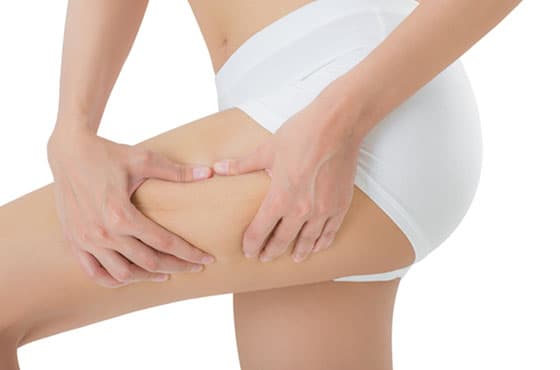The thighs are one of the areas of the human body where unwanted fat tends to accumulate. The most common form of fat accumulation by far is saddlebags, where the fat cells are stored from the waist down to the thighs. Not only are they considered unattractive, they also involve some risks. Very large thighs increase the risk of severely limited mobility. In the summer, there is also the risk of inflammation when the insides of the thighs sweat and rub together while walking or sitting. These risks can be avoided with liposuction.
Read more about liposuction on the thighs in the expert article by Dr Hofheinz on Jameda
Go to the Jameda article

The plastic surgeon refers to this type of fat removal as liposuction. General anaesthesia is not required for liposuction as a special solution is injected into the area to be treated beforehand. It mainly consists of isotonic water mixed with some adrenalin, sodium carbonate and a local anaesthetic. This technique is also called tumescent anaesthesia. It loosens the fat cells from the connective tissue and provides local anaesthesia. This makes it easier to gently remove the fat cells. We use microcannulas at the Klinik am Rhein. Their small size means that they do not require any access points that have to be sutured. Liposuction is also performed using vibrations (PAL= Power-Assisted Lipoplasty). This method makes the cannulas vibrate and allows the procedure to be performed in a precise manner. It is also very gentle on the important surrounding structures (connective tissue, blood vessels and nerves).

The type of anaesthesia and the use of cannulas in the connective tissue cause the fatty tissue to become loose. Furthermore, removing the fat cells from specific areas creates tiny cavities, in which the connective tissue must grow back together again. Therefore, strenuous activities should be avoided for four to six weeks after liposuction on the legs. The patients also have to wear a special garment for a few days that compress the treated areas. Optimum results can only be achieved if patients follow the doctor’s instructions. Patients will not be able to see the full final result of the procedure straight after surgery. The reason is that the mechanical irritation of the tissue usually causes slight swelling that will disappear after a few days without any additional intervention. Patients do not usually suffer from severe pain after undergoing liposuction.
The big advantage is that liposuction completely removes the fat cells and does not just empty them, as is the case with natural weight loss. This suggests that the result of liposuction is permanent as the number of fat cells can no longer be changed. However, it is useful to follow a healthy and low-fat diet and get regular exercise for a sustainable result.
If there is an extensive amount of fat cells to be removed or the patient has had these fat deposits for a long time, the ability of the skin and the connective tissue to completely retract by itself can be impaired. This usually causes excess sagging folds of skin. Our plastic surgeons thus offer a combination of liposuction on the legs with a surgical thigh lift. It can also be performed with local anaesthetic or twilight anaesthesia. However, proper wound treatment must be ensured after the procedure to avoid complications.
Call us (0211-55028780) or arrange an appointment with your doctor using our online calendar. Find available appointments.
Arrange a consultation online